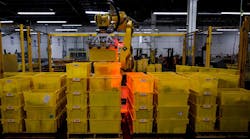With Amazon retraining its workforce to the tune of $700 million, nearly a third of the company’s U.S. workers will become accustomed to more tech-intensive responsibilities. This effort—one of the most historically forceful on Amazon’s part—sets the stage for the company to figure out whether its stated mission of ditching its own human workforce in favor of smart robots is a go.
The tech behemoth has made no secret of its desire to go fully automated: It’s been investing in automation technology for years. In 2017, Amazon had over 100,000 robots “working” in warehouses around the world, and just recently, news surfaced that it has started replacing human packers with so-called CartonWrap robots in some warehouses.
So it came as a bit of a shock earlier this month when the company said that full automation is at least a decade away. During a tour of a Baltimore fulfillment center, Scott Anderson, director of Amazon Robotics Fulfillment, told reporters that the current “limited technology” is no match for human cognitive ability. For now, Amazon’s 600,000-plus employees will work alongside the robots, which—surprisingly—perform only a fraction of tasks, mostly limited to moving large stacks of products in the warehouses. They simply lack the higher-order cognitive abilities, like applying insight and making decisions, that are required for more precise, nuanced work.
Amazon’s revelation might serve as a warning to other companies that singularly prioritize automation over human workers. There is such a thing as too much, too soon.
This past January, executives at Davos were outed for openly discussing the desire to replace human workers with machines on a mass scale. But in reality, the risks of doing this are often far too high. Automation is most effective when it is designed with human users in mind.
Humans and automation technology serve different purposes
In 1961, workers at a General Motors factory began working alongside the first industrial robot. Called Unimate, the 4,000-pound arm was a “cobot” that welded and die-cast car components alongside its human counterparts.
More than 50 years later, Unimate still remains the model for how humans and machines coexist on the factory floor. The reason? Automation works best when it is designed to enhance humans’ abilities. Human-centered automation, as this philosophy is called, eliminates the boring, tedious or dangerous jobs humans have previously been asked to perform. While humans maintain a central role in the workplace, automation can run in the background, assisting workers along the way.
Today, modern versions of Unimate are popping up in manufacturing and non-manufacturing contexts alike. Boutique manufacturers—like Brooklyn’s Lowercase, a company that manufactures eyeglasses in-house—are investing in automated solutions that complete repetitive tasks with more precision than humans. Similarly, Salesforce’s CRM software can now automatically send hundreds of perfectly timed follow-up emails on behalf of a busy sales rep, and chatbots on e-commerce sites instantly respond to common customer questions.
These tasks are well-suited for technology because they are repetitive and require little judgment or creativity. However, they still require intervention from humans who have the critical-thinking skills to handle more complex situations. Just as we would never hand our email communication entirely off to an automated program, we can’t rely on automation to fly planes or do quality assurance on complex auto parts. Machines simply aren't as good at handling the unexpected or adjusting to new requirements as humans.
Companies that don’t prioritize human workers will fall behind
Companies that implement new automation technology without transparency—or that fail to consider how it will impact their workers’ experiences—are likely to suffer reputational damage.
In March, Tesla—previously known as a forward-thinking company—was criticized for routinely bypassing safety requirements. At Amazon, technology-powered overreach has sparked pushback from warehouse employees and office workers alike; the company has been criticized for everything from demanding constant availability over email to filing a patent for an unsettling cage designed to protect warehouse workers from its robots.
In more extreme cases, some companies actively require low-level employees to implement technology that will make their colleagues obsolete. Last summer, an MIT Technology Review editor recalled an internship in which she was asked to design a 3D printing solution that would reduce the costs associated with a molding process—only to realize that the company intended to replace the worker who spent more than 30 years developing it. Even if these companies don’t suffer public reputational damage, this approach can severely undermine morale and create suspicion among the remaining employees.
A more human-centered approach
Before adopting new automation technology, companies need to take a hard look at whether it will actually improve worker efficiency and output. In factories, this difference is often stark: Compare a plant that has not only digitized its paper-based work procedures but is also collecting and analyzing that data to continuously improve work productivity, quality and safety, to a factory floor where workers rely on walkie-talkies, binders full of paper and their own memories and it’s easy to see why automation—used in the right way—is urgently needed.
Finally, companies should never forget that they have a valuable resource for evaluating new technology: their workers. Most employees, especially those in industries underserved by Silicon Valley and its brethren, will embrace technology that makes their day-to-day work easier and more productive. Automation technology also provides employees an opportunity to upskill and to focus on the higher-order, more nuanced work that humans still do best. By engaging in transparent dialogue with the people whose lives will be directly impacted by new technology, companies can ensure that humans will remain at the heart of their operations.
For now, both humans and robots are here to stay. Automation, artificial intelligence and other technology can drive significant benefits for businesses—as long as they invest in human workers, too.
